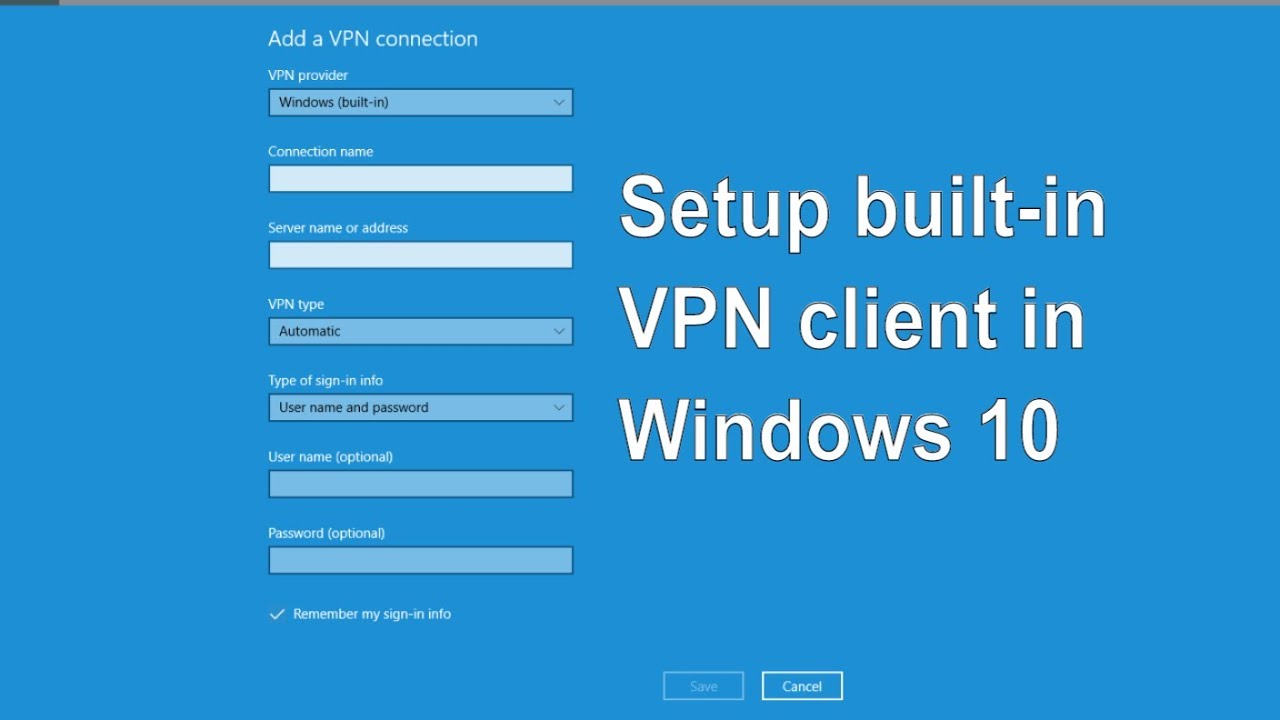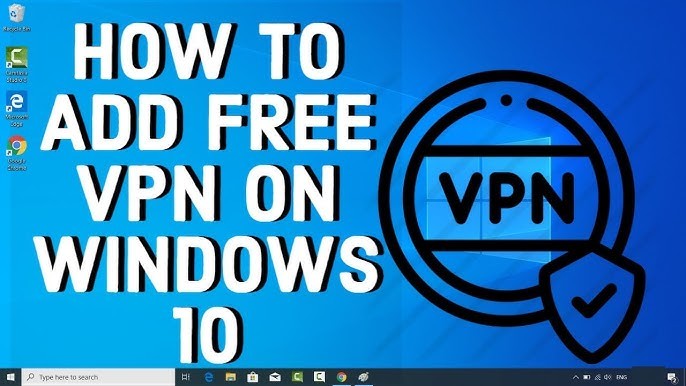In today's digitally connected world, safeguarding your online activities has become paramount. Whether you're concerned about privacy, security, or accessing geo-restricted content, a Virtual Private Network (VPN) offers a solution. In this comprehensive guide, we'll walk you through the process of setting up the best free VPN on Windows 10. From understanding the benefits to troubleshooting common issues, we've got you covered.

Unlocking Online Freedom with the Best VPN Right Now
In today's digitally connected world, safeguarding your online activities has become paramount. Whether you're concerned about privacy, security, or accessing geo-restricted content, a Virtual Private Network (VPN) offers a solution. In this comprehensive guide, we'll walk you through the process of setting up the best free VPN on Windows 10. From understanding the benefits to troubleshooting common issues, we've got you covered.
Navigating the Importance of VPNs on Windows 10
In the digital realm, where privacy breaches and cyber threats loom large, utilizing a VPN on your Windows 10 device is no longer just an option—it's a necessity. By encrypting your internet connection and masking your IP address, VPNs offer a secure pathway for your data to travel, shielding it from prying eyes and potential cyberattacks.
Understanding the Benefits of Utilizing a Virtual Private Network Free of Charge
The allure of a free VPN is undeniable, especially for budget-conscious users seeking to bolster their online security without breaking the bank. With a virtual private network free of charge, you can enjoy enhanced privacy, unrestricted access to global content, and peace of mind knowing your sensitive information remains safeguarded from third-party surveillance.
Exploring the Best VPN Apps for Windows 10
When it comes to selecting the right VPN app for your Windows 10 device, the options abound. From industry giants to emerging contenders, each VPN app boasts unique features and functionalities designed to cater to diverse user preferences. By conducting thorough research and considering factors such as server locations, encryption protocols, and user interface, you can narrow down your choices and find the perfect VPN app to suit your needs.
Setting Up Your VPN Gateway on Windows 10 A Step-by-Step Guide
Creating a VPN gateway on Windows 10 is a straightforward process that requires minimal technical expertise. By following a few simple steps, you can configure your device to establish a secure connection to a remote server, thereby encrypting your internet traffic and safeguarding your online activities from potential threats.
Accessing VPN Services Online
With an abundance of VPN services available vpn online, selecting the right provider can seem like a daunting task. However, by prioritizing factors such as server network size, connection speed, and privacy policies, you can make an informed decision and choose a reputable VPN service that aligns with your specific requirements.
Installing a VPN Application on Windows 10
Installing a VPN application on your Windows 10 device is a breeze, thanks to user-friendly interfaces and intuitive installation wizards. By downloading the app from a trusted source and following the on-screen instructions, you can quickly set up your VPN and begin enjoying enhanced security and privacy while browsing the web.
Exploring Free VPN Options for Windows 10
In the realm of vpn free doesn't always mean inferior. Many reputable VPN providers offer free versions of their services, allowing users to enjoy basic security features without shelling out a single penny. By leveraging these free VPN options for Windows 10, you can fortify your digital defenses without putting a strain on your budget.
Empowering Users to Take Control of Their Online Privacy
Downloading a VPN for Windows 10 is a straightforward process that requires only a few minutes of your time. By selecting a reputable provider, navigating to their website, and following the prompts to download the software, you can equip your device with powerful encryption capabilities and take control of your online privacy.
Evaluating Free VPNs for Windows 10
Not all free VPNs are created equal. While some offer robust security features and reliable performance, others may fall short in terms of speed and server availability. By carefully evaluating your options and considering factors such as encryption strength, data logging policies, and server locations, you can choose a free VPN for Windows 10 that meets your needs without compromising on quality.
Configuring VPN Settings on Windows 10
Once you've installed a VPN on your Windows 10 device, it's time to configure the settings to suit your preferences. From selecting your preferred encryption protocol to choosing your desired server location, customizing your VPN settings allows you to tailor your security measures to align with your unique requirements.
Troubleshooting Common VPN Issues on Windows 10
Despite their many benefits, VPNs are not immune to technical glitches and connectivity issues. From slow connection speeds to server errors, troubleshooting common VPN problems on Windows 10 requires patience and persistence. By following a systematic approach and utilizing built-in troubleshooting tools, you can identify and resolve issues quickly, ensuring uninterrupted access to the web.
Ensuring Security and Privacy with Your VPN on Windows 10 Protecting Your Digital Footprint
In an era marked by rampant data breaches and online surveillance, safeguarding your digital footprint has never been more important. By harnessing the power of a VPN on your Windows 10 device, you can encrypt your internet connection, mask your IP address, and protect your sensitive information from prying eyes.
Exploring Additional Features of VPNs for Windows 10 Unlocking Hidden Benefits
Beyond their core functionality, VPNs offer a myriad of additional features designed to enhance your online experience. From ad-blocking capabilities to split tunneling functionality, exploring the full range of features available with your VPN for Windows 10 allows you to unlock hidden benefits and maximize your privacy and security.
Tips for Using a VPN on Windows 10 Effectively Maximizing Your Online Protection
To maximize the benefits of your VPN on Windows 10, it's essential to adopt best practices and implement effective strategies for using the service. From choosing secure passwords to enabling automatic updates, incorporating these tips into your daily routine allows you to fortify your digital defenses and enjoy a safer, more secure online experience.
Embracing the Power of VPNs on Windows 10
As we navigate an increasingly interconnected world, the importance of safeguarding our online activities cannot be overstated. By harnessing the power of a VPN on your Windows 10 device, you can protect your privacy, secure your data, and unlock a world of digital possibilities—all with the click of a button. So why wait? Take control of your online destiny today and experience the freedom and security that only a VPN can provide.
Why and When to Use VPN on Windows 10
VPN provides an encrypted tunnel for your internet traffic, shielding your data from prying eyes and potential cyber threats. Whether you're browsing the web, streaming content, or accessing sensitive information, VPN ensures your online activities remain private and secure. It's especially beneficial when connecting to public Wi-Fi networks or accessing geo-restricted content.
How to Get VPN on Windows 10 Easy Installation Process
Getting started with VPN on Windows 10 is quick and hassle-free. Simply visit the website, sign up for an account, and download the Windows app. Once vpn download, follow the on-screen instructions to install the app on your device, and you'll be ready to enjoy enhanced privacy and security in no time.
Expanding the Step-by-Step Guide to Creating a VPN in Windows 10
Open Settings:
- Click on the Start menu located at the bottom left corner of your screen.
- Select the Settings icon, represented by a gear or cogwheel, to open the Settings app.
Navigate to Network & Internet:
- Within the Settings window, you'll find various categories. Click on Network & Internet, usually represented by a globe and a cable icon.
VPN Settings:
- In the Network & Internet section, locate the left-hand menu and scroll down until you find VPN.
- Click on VPN to access the VPN settings.
Add a VPN Connection:
- Under the VPN section, you'll see an option to Add a VPN connection. Click on this option to proceed.
Configure VPN Settings:
- Upon clicking Add a VPN connection, a new window will appear, prompting you to enter specific details for your VPN connection.
- Enter the following information:
- VPN Provider: Choose your VPN provider from the dropdown menu. If you're using a custom VPN service, select Windows (built-in).
- Connection Name: Give your VPN connection a descriptive name for easy identification.
- Server Address: Enter the server address provided by your VPN provider. This could be an IP address or a domain name.
- VPN Type: Select the VPN protocol or type. Common options include PPTP, L2TP/IPsec, SSTP, IKEv2, and OpenVPN.
- Sign-in Information: Depending on the VPN type chosen, you may need to provide additional sign-in information such as username, password, and domain (if applicable).
- Optionally, you can also configure advanced settings by clicking on the Advanced options link.
Connect to VPN:
- After configuring the VPN settings, click on the Save button to save your VPN connection.
- Once saved, return to the VPN settings window.
- Under the VPN section, you'll now see the newly created VPN connection listed.
- To connect to the VPN, click on the VPN connection name, then click the Connect button.
- You may be prompted to enter your username and password if required by your VPN provider.
- Windows will then attempt to establish a secure connection to the VPN server. Once connected, you'll see a confirmation message indicating a successful connection.
By following these detailed steps, you can easily create and configure a VPN connection on your Windows 10 device, ensuring enhanced security and privacy for your online activities.
Automatic Configuration of VPN on Windows 10
VPN offers automatic configuration settings, making it incredibly easy to set up on Windows 10. Upon installation, the app will automatically detect your network settings and configure the VPN accordingly, ensuring seamless integration with your existing internet connection. This hands-free approach simplifies the setup process, allowing you to start protecting your online activities with minimal effort.
Manual Configuration of VPN on Windows 10
For users who prefer more control over their VPN settings, VPN also offers manual configuration options on Windows 10. By accessing the app's settings menu, you can customize various parameters such as server selection, protocol preferences, and kill switch functionality. This level of flexibility empowers users to tailor their VPN experience to suit their specific needs and preferences.
Detailed Comparison
Built-in VPN Setup:
- Windows 10: Windows 10 offers built-in VPN functionality, allowing users to set up and manage VPN connections without the need for third-party software. This feature is accessible through the "Settings" app under the "Network & Internet" section.
VPN Protocols Supported:
- Windows 10: Windows 10 supports various VPN protocols, including PPTP, L2TP/IPsec, SSTP, IKEv2, and OpenVPN. The availability of these protocols may depend on the VPN provider you choose.
Ease of Setup:
- Windows 10: Setting up a VPN on Windows 10 is relatively straightforward, thanks to the built-in VPN configuration wizard. Users can simply navigate to the "Settings" app, select "Network & Internet," and then choose "VPN" to add a new VPN connection.
Security Features:
- Windows 10: Windows 10 offers built-in security features for VPN connections, including encryption and authentication protocols. Users can configure these settings based on their security preferences and the capabilities of their VPN provider.
Integration with Third-party VPN Services:
- Windows 10: Windows 10 seamlessly integrates with third-party VPN services, allowing users to connect to VPN servers provided by their chosen VPN service provider. Users can download and install VPN client software from their provider and configure VPN connections using the built-in VPN settings.
Advantages and Benefits of Using VPN on Windows 10
The advantages of using VPN on Windows 10 are numerous, including:
- Enhanced security: VPN encrypts your internet traffic, preventing third parties from intercepting and eavesdropping on your data.
- Privacy protection: By masking your IP address, VPN ensures your online activities remain anonymous and private.
- Access to geo-restricted content: VPN allows you to bypass geo-blocking restrictions, enabling you to access content from around the world.
- High-speed connections: With a global network of servers optimized for speed and reliability, VPN delivers fast and stable connections for seamless browsing and streaming.
- Multi-device compatibility: VPN supports multiple devices and platforms, allowing you to protect all your devices with a single subscription.
Experience the Ultimate Online Privacy and Security with VPN on Windows 10
In an age where digital threats are ever-present, safeguarding your online privacy and security is non-negotiable. With VPN, you can enjoy peace of mind knowing that your sensitive information is protected against hackers, spies, and other malicious actors. So why wait? Take control of your online destiny today and experience the ultimate in privacy and security with VPN on Windows 10.











